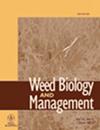Field validation of 4,8‐dihydroxy‐1‐tetrahydronaphthone phytotoxicity on forestland weeds and physiological mechanism analysis on Lindernia procumbens
IF 1.5
4区 农林科学
Q3 AGRONOMY
引用次数: 0
Abstract
4,8‐Dihydroxy‐1‐tetrahydronaphthone (4,8‐DHT), an allelochemical, was isolated from the4,8-二羟基-1-四氢萘醌对林地杂草的植物毒性田间验证及对扁柏的生理机制分析
从 Carya cathayensis 外果皮中分离出的 4,8-二羟基-1-四氢萘酮(4,8-DHT)是一种等位化学物质,在实验室测试中被发现具有植物毒性。本研究设计了田间试验,以评估 4,8-DHT 在萌芽前和萌芽后施用对 Cerasus yedoensis 和 Lagerstroemia indica 林地杂草的植物毒性,此外还测量了对 Lindernia procumbens 的生理影响。4,8-DHT的植物毒性结果表明,在2021年,4,8-DHT在C. yedoensis林地和L. indica林地的芽前施药24天后,对杂草的总抑制率分别为81.3%和68.2%,与芽后处理相比,分别提高了9.9%和27.8%。特别是在C. yedoensis林地,萌前8天后喷施高浓度的4,8-DHT,对除香附子外的所有杂草都有显著的抑制率,24天后抑制率仍在80.0%以上。4,8-DHT的综合防效表明,芽前施药更有利于防除杂草。生理学分析表明,4,8-DHT 会刺激硫代巴比妥酸活性物质(TBARS)、过氧化氢(H2O2)和脯氨酸的含量,并降低抗氧化酶的活性,同时还会降低草地匍匐茎的根系活力和叶绿素含量。这些结果表明,有必要进一步研究在萌芽前早期施用 4,8-DHT 作为除草剂的可能性。
本文章由计算机程序翻译,如有差异,请以英文原文为准。
求助全文
约1分钟内获得全文
求助全文
来源期刊

Weed Biology and Management
农林科学-农艺学
CiteScore
2.70
自引率
0.00%
发文量
13
审稿时长
>36 weeks
期刊介绍:
Weed Biology and Management is an international journal, published four times per year. The journal accepts contributions in the form of original research and review articles in all aspects of weed science. Contributions from weed scientists in the Asia–Pacific region are particularly welcomed.
The content of the contributions may relate to weed taxonomy, ecology and physiology, weed management and control methodologies, herbicide behaviors in plants, soils and environment, utilization of weeds and other aspects of weed science. All contributions must be of sufficient quality to extend our knowledge in weed science.
 求助内容:
求助内容: 应助结果提醒方式:
应助结果提醒方式:


